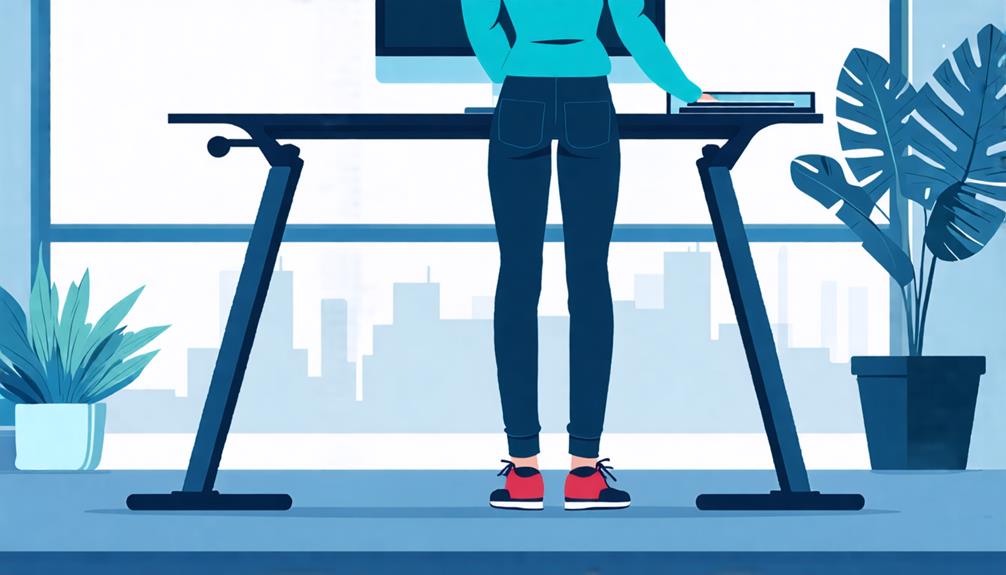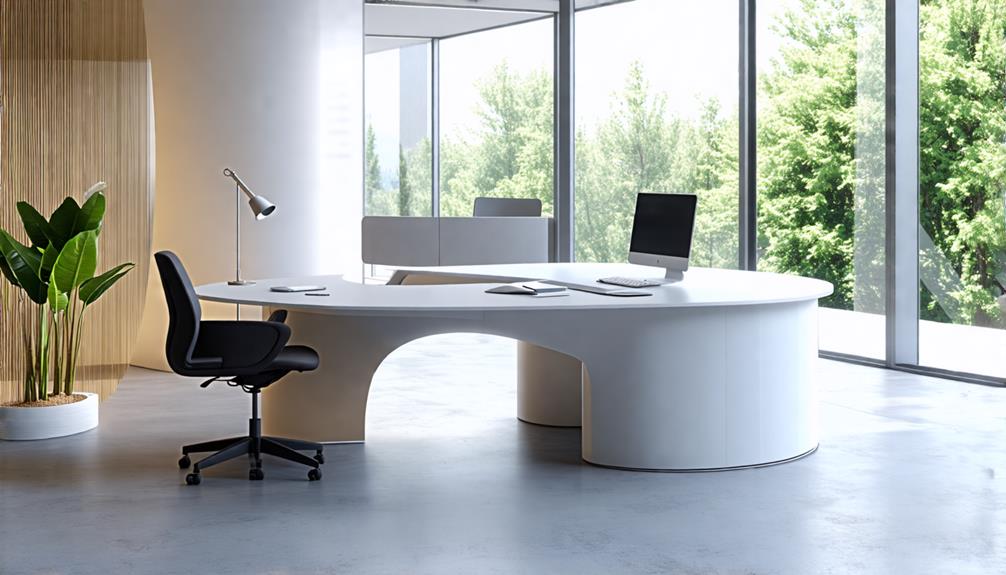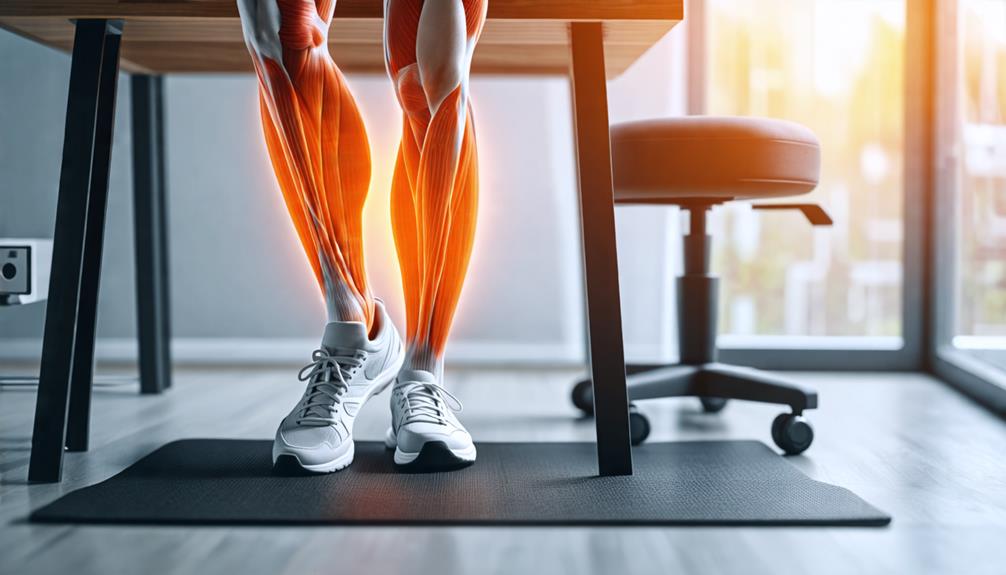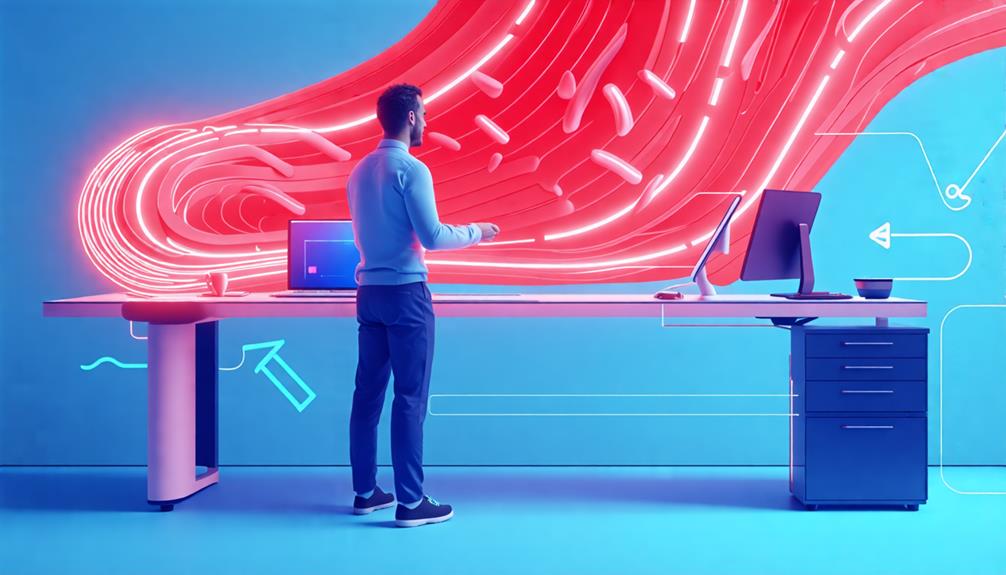Standing Desks Soothe Back Pain in 7 Surprising Ways

Using a standing desk can be a surprising remedy for back pain, offering seven significant benefits. It promotes proper posture, encouraging upright alignment and reducing strain on the neck and lower back. Alternating between sitting and standing also fosters continuous movement, which prevents stiffness and improves overall comfort. Additionally, standing desks engage core muscles, reduce sustained spinal pressure, and improve circulation. They even boost energy levels and increase flexibility. As you learn more about these advantages, you'll uncover how standing desks can transform your work routine and ease back pain.
Promotes Proper Posture

When using a standing desk, you maintain a more upright posture, reducing the likelihood of back pain caused by sitting for extended periods. This is because standing desks facilitate better spinal alignment by encouraging you to maintain a neutral position.
Placing your monitor at eye level keeps your neck and back straight, minimizing strain on your spine. Proper ergonomics also play a vital role. Make certain your arms are at a 100-degree angle while typing, and use a wrist pad for your mouse to prevent unnecessary strain.
Standing while working naturally encourages you to adjust your posture, as slouching becomes less comfortable when you're on your feet. Regular use of standing desks has been linked to a notable 32% improvement in lower back pain.
Encourages Continuous Movement

By switching between standing and sitting, you guarantee continuous movement throughout your workday, shedding stiffness that can creep in from prolonged sitting.
Small movements like shifting your weight, lifting your legs, or doing gentle stretches while standing keep your joints active and engaged.
This constant activity helps maintain a healthy balance and positions you for long-term back comfort.
Continuous Movement for Comfort
You'll find that standing desks encourage continuous movement, which helps prevent stiffness and discomfort.
The subtle shift in weight or discreet leg lifts can make a big difference in your overall comfort. These small movements while standing engage your muscles and improve circulation, ultimately reducing the risk of back pain.
When you incorporate standing into your workday, you tend to shift positions more frequently compared to traditional seated work. This can help alleviate muscle imbalances and promote better spinal health.
Research shows
Improves Posture During Work
Standing at your desk encourages you to maintain a better posture, keeping your spine upright and arms at a 100-degree angle to prevent shoulder and neck strain. This is particularly important for those who spend long hours working at their desks, as poor posture can lead to back pain and musculoskeletal issues. By using a standing desk, you're more likely to maintain proper spinal alignment and reduce muscle imbalances associated with long periods of sitting.
Maintaining Proper Posture: Standing desks help you keep your spine upright, reducing compression and strain on your back.
Ergonomic Alignment: A 100-degree angle for your arms prevents strain on your shoulders and neck.
Regular Movement: Alternating between standing and sitting encourages natural movement and can correct muscle imbalances.
Overall Health Benefits: Standing desks lead to better posture and can result in significant improvements in back pain and overall musculoskeletal health.
Strengthens Core Muscles

Using a standing desk regularly encourages you to engage your core muscles more actively, which can help strengthen them over time.
As you stand while working, your core is constantly working to maintain good posture and support your back health.
This engagement can lead to a stronger core, providing better support for your spine, and potentially reducing the risk of back pain associated with weak abdominal and back muscles.
Incorporating standing into your work routine promotes the use of stabilizing muscles, enhancing overall core strength and stability.
Reduces Sustained Pressure

Reduces Sustained Pressure
When you switch between sitting and standing at your desk, you reduce the sustained pressure on your spine, promoting better spinal alignment and potentially alleviating chronic back pain. This alternating posture helps maintain the natural curvature of your spine, which is often compromised when sitting for extended periods.
In fact, prolonged sitting can lead to disc compression in the lower back, but by integrating a standing desk, you can alleviate this pressure, thereby reducing the risk of back pain.
Here are some key benefits to reflect upon:
- Better Spinal Alignment: Standing allows your spine to align naturally, reducing pressure on the discs and promoting a healthier posture.
- Reducing Pressure on Discs: Alternating between sitting and standing reduces the static load on your spine, which in turn lessens the risk of developing chronic back pain.
- Comfortable Ergonomics: An adjustable standing desk encourages you to maintain a loose, slightly bent knee position, distributing weight evenly and reducing strain on your lower back.
Enhances Circulation

Using a standing desk can make a significant difference in your daily health.
For one, it boosts blood flow, which reduces leg swelling and other issues related to prolonged sitting.
Boosts Blood Flow
Building on the foundation of enhancing circulation, standing desks take it a step further by boosting blood flow. This significant improvement can have a substantial impact on your overall health, particularly regarding cardiovascular health.
Standing actively engages your muscles, promoting better blood flow by enhancing overall circulation and reducing the risk of blood clots. This increased blood flow delivers oxygen and nutrients more efficiently throughout your body, which can lead to numerous health benefits.
Some of the key advantages of standing desks include:
- Improved Cardiovascular Health: Standing promotes heart function and circulation compared to sitting for extended periods.
- Reduced Muscular Stiffness: By engaging your muscles, standing desks can prevent stiffness often associated with sedentary behavior.
- Enhanced Nutrient Delivery: Increased blood flow ensures that essential nutrients are distributed efficiently across your body.
Reduces Leg Swelling
Standing at your desk helps you avoid the dreaded leg swelling that emerges after hours of sitting still. This benefit arises from the improved circulation brought about by regular movement. When you sit for prolonged periods, fluid tends to accumulate in your lower extremities, causing discomfort and potentially dangerous health risks like deep vein thrombosis. To combat this, standing desks encourage more frequent movement, engaging muscles in your legs and maintaining ideal blood flow. This helps lower the risk of fluid retention and guarantees that your cardiovascular system functions at its best. Here's a breakdown of how standing desks improve circulation:
| Aspect | Benefit | Description |
|---|---|---|
| Muscle Engagement | Improved Blood Flow | Standing engages your leg muscles, improving circulation and blood flow. |
| Fluid Retention | Reduced Leg Swelling | Regular movement prevents fluid accumulation in the legs, reducing swelling and discomfort. |
| Health Risks | Lower Risk of DVT | Improved circulation and muscle engagement reduce the risk of deep vein thrombosis.
Boosts Energy and Mood

By integrating standing desks into your daily routine, you can visibly reduce sluggishness and fatigue, resulting from prolonged sitting, and inject energy and enthusiasm into your work. This boost in energy culminates in a profound impact on your mental health. It has been noted that 87% of individuals report feeling more energized after standing for just one hour.
Additionally:
- Choosing a standing desk leads to increased participation in daily tasks and responsibilities, as users feel more alert and engaged.
- The action of standing can considerably improve focus and performance through the reduction of sedentary behavior.
- Implementing standing breaks in the workday helps rid feelings of lethargy, thereby improving overall work productivity and job satisfaction.
Improves Flexibility and Stretching

Using a standing desk prompts you to incorporate regular stretching and movement throughout your day, which can greatly improve your flexibility and mobility. This is especially important now, as prolonged sitting has become a common issue in many workplaces, leading to reduced flexibility and increased discomfort. By using a standing desk, you can break out of this sedentary routine and incorporate more dynamic movement into your daily routine. This can include simple exercises like side bends, calf raises, or even a quick spin around the office.
In addition to static stretching, a standing desk also facilitates natural movement patterns, which can boost muscle elasticity and joint flexibility over time. This reduces the risk of injury and further back pain, especially in critical areas like the lower back.
Benefits of Standing Desks for Flexibility
| Movement Type | Benefits | Frequency |
|---|---|---|
| Basic Stretching | Boosts flexibility | 2-3 times a day |
| Dynamic Movement | Improves spine flexibility, reduces stiffness | Throughout the workday |
| Natural Movement | Boosts muscle elasticity and joint flexibility | Ongoing throughout the day |
Conclusion
Stand up and take control of your back pain with a standing desk.